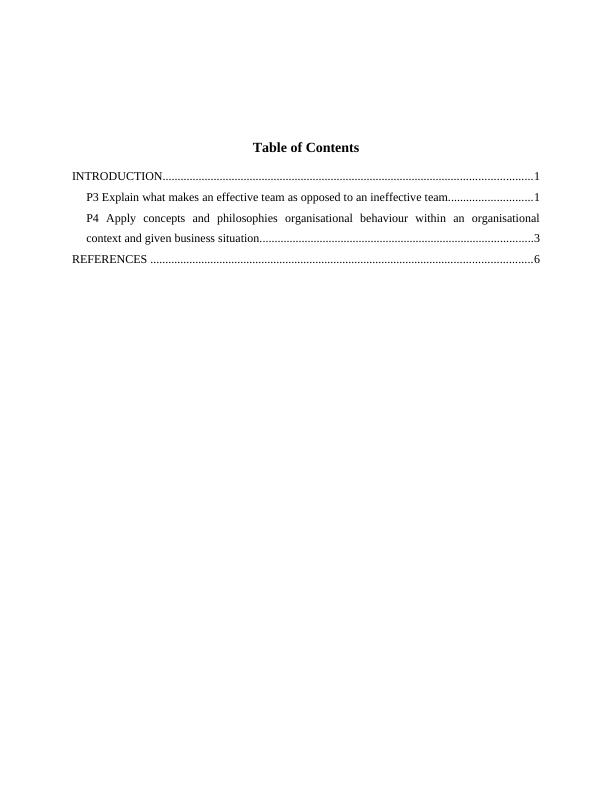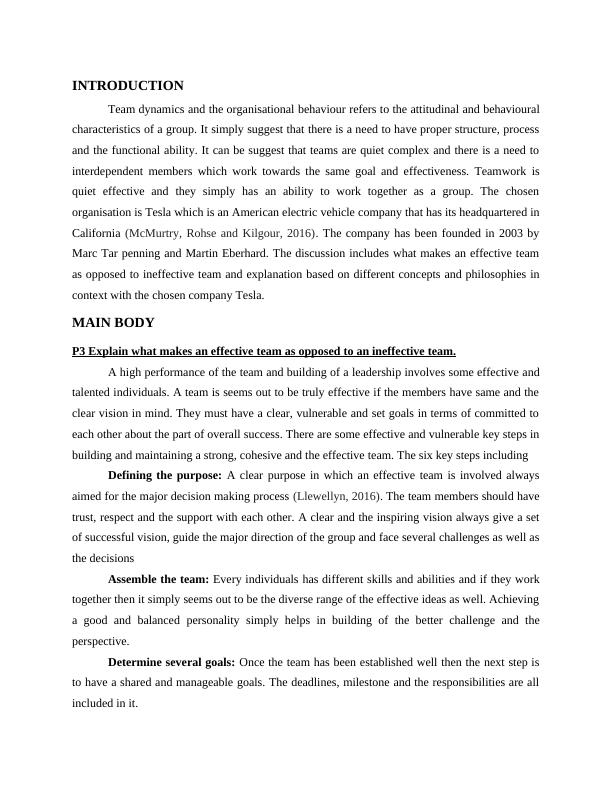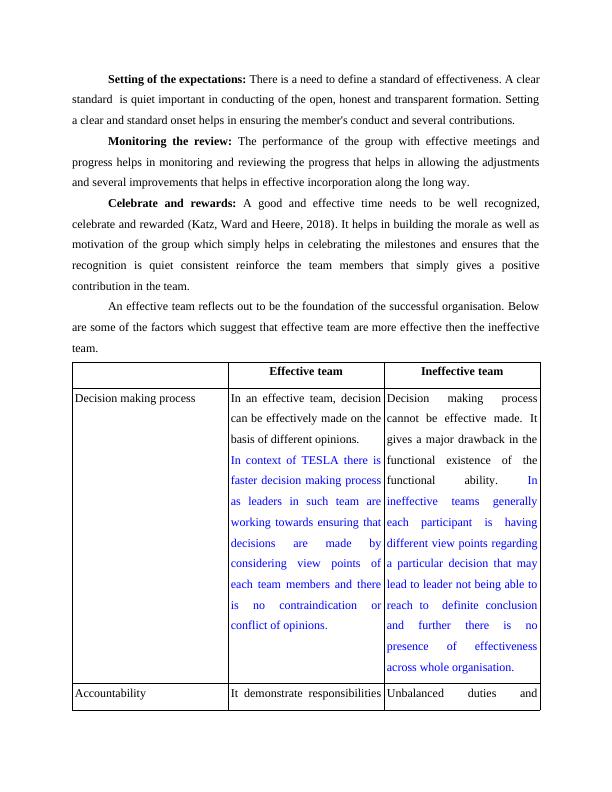Team Dynamics and Organisational Behaviours
Added on 2023-01-05
11 Pages2359 Words46 Views
Team Dynamics and
Organisational
Behaviours
Organisational
Behaviours

Table of Contents
INTRODUCTION...........................................................................................................................1
P3 Explain what makes an effective team as opposed to an ineffective team............................1
P4 Apply concepts and philosophies organisational behaviour within an organisational
context and given business situation...........................................................................................3
REFERENCES ...............................................................................................................................6
INTRODUCTION...........................................................................................................................1
P3 Explain what makes an effective team as opposed to an ineffective team............................1
P4 Apply concepts and philosophies organisational behaviour within an organisational
context and given business situation...........................................................................................3
REFERENCES ...............................................................................................................................6

INTRODUCTION
Team dynamics and the organisational behaviour refers to the attitudinal and behavioural
characteristics of a group. It simply suggest that there is a need to have proper structure, process
and the functional ability. It can be suggest that teams are quiet complex and there is a need to
interdependent members which work towards the same goal and effectiveness. Teamwork is
quiet effective and they simply has an ability to work together as a group. The chosen
organisation is Tesla which is an American electric vehicle company that has its headquartered in
California (McMurtry, Rohse and Kilgour, 2016). The company has been founded in 2003 by
Marc Tar penning and Martin Eberhard. The discussion includes what makes an effective team
as opposed to ineffective team and explanation based on different concepts and philosophies in
context with the chosen company Tesla.
MAIN BODY
P3 Explain what makes an effective team as opposed to an ineffective team.
A high performance of the team and building of a leadership involves some effective and
talented individuals. A team is seems out to be truly effective if the members have same and the
clear vision in mind. They must have a clear, vulnerable and set goals in terms of committed to
each other about the part of overall success. There are some effective and vulnerable key steps in
building and maintaining a strong, cohesive and the effective team. The six key steps including
Defining the purpose: A clear purpose in which an effective team is involved always
aimed for the major decision making process (Llewellyn, 2016). The team members should have
trust, respect and the support with each other. A clear and the inspiring vision always give a set
of successful vision, guide the major direction of the group and face several challenges as well as
the decisions
Assemble the team: Every individuals has different skills and abilities and if they work
together then it simply seems out to be the diverse range of the effective ideas as well. Achieving
a good and balanced personality simply helps in building of the better challenge and the
perspective.
Determine several goals: Once the team has been established well then the next step is
to have a shared and manageable goals. The deadlines, milestone and the responsibilities are all
included in it.
Team dynamics and the organisational behaviour refers to the attitudinal and behavioural
characteristics of a group. It simply suggest that there is a need to have proper structure, process
and the functional ability. It can be suggest that teams are quiet complex and there is a need to
interdependent members which work towards the same goal and effectiveness. Teamwork is
quiet effective and they simply has an ability to work together as a group. The chosen
organisation is Tesla which is an American electric vehicle company that has its headquartered in
California (McMurtry, Rohse and Kilgour, 2016). The company has been founded in 2003 by
Marc Tar penning and Martin Eberhard. The discussion includes what makes an effective team
as opposed to ineffective team and explanation based on different concepts and philosophies in
context with the chosen company Tesla.
MAIN BODY
P3 Explain what makes an effective team as opposed to an ineffective team.
A high performance of the team and building of a leadership involves some effective and
talented individuals. A team is seems out to be truly effective if the members have same and the
clear vision in mind. They must have a clear, vulnerable and set goals in terms of committed to
each other about the part of overall success. There are some effective and vulnerable key steps in
building and maintaining a strong, cohesive and the effective team. The six key steps including
Defining the purpose: A clear purpose in which an effective team is involved always
aimed for the major decision making process (Llewellyn, 2016). The team members should have
trust, respect and the support with each other. A clear and the inspiring vision always give a set
of successful vision, guide the major direction of the group and face several challenges as well as
the decisions
Assemble the team: Every individuals has different skills and abilities and if they work
together then it simply seems out to be the diverse range of the effective ideas as well. Achieving
a good and balanced personality simply helps in building of the better challenge and the
perspective.
Determine several goals: Once the team has been established well then the next step is
to have a shared and manageable goals. The deadlines, milestone and the responsibilities are all
included in it.

Setting of the expectations: There is a need to define a standard of effectiveness. A clear
standard is quiet important in conducting of the open, honest and transparent formation. Setting
a clear and standard onset helps in ensuring the member's conduct and several contributions.
Monitoring the review: The performance of the group with effective meetings and
progress helps in monitoring and reviewing the progress that helps in allowing the adjustments
and several improvements that helps in effective incorporation along the long way.
Celebrate and rewards: A good and effective time needs to be well recognized,
celebrate and rewarded (Katz, Ward and Heere, 2018). It helps in building the morale as well as
motivation of the group which simply helps in celebrating the milestones and ensures that the
recognition is quiet consistent reinforce the team members that simply gives a positive
contribution in the team.
An effective team reflects out to be the foundation of the successful organisation. Below
are some of the factors which suggest that effective team are more effective then the ineffective
team.
Effective team Ineffective team
Decision making process In an effective team, decision
can be effectively made on the
basis of different opinions.
In context of TESLA there is
faster decision making process
as leaders in such team are
working towards ensuring that
decisions are made by
considering view points of
each team members and there
is no contraindication or
conflict of opinions.
Decision making process
cannot be effective made. It
gives a major drawback in the
functional existence of the
functional ability. In
ineffective teams generally
each participant is having
different view points regarding
a particular decision that may
lead to leader not being able to
reach to definite conclusion
and further there is no
presence of effectiveness
across whole organisation.
Accountability It demonstrate responsibilities Unbalanced duties and
standard is quiet important in conducting of the open, honest and transparent formation. Setting
a clear and standard onset helps in ensuring the member's conduct and several contributions.
Monitoring the review: The performance of the group with effective meetings and
progress helps in monitoring and reviewing the progress that helps in allowing the adjustments
and several improvements that helps in effective incorporation along the long way.
Celebrate and rewards: A good and effective time needs to be well recognized,
celebrate and rewarded (Katz, Ward and Heere, 2018). It helps in building the morale as well as
motivation of the group which simply helps in celebrating the milestones and ensures that the
recognition is quiet consistent reinforce the team members that simply gives a positive
contribution in the team.
An effective team reflects out to be the foundation of the successful organisation. Below
are some of the factors which suggest that effective team are more effective then the ineffective
team.
Effective team Ineffective team
Decision making process In an effective team, decision
can be effectively made on the
basis of different opinions.
In context of TESLA there is
faster decision making process
as leaders in such team are
working towards ensuring that
decisions are made by
considering view points of
each team members and there
is no contraindication or
conflict of opinions.
Decision making process
cannot be effective made. It
gives a major drawback in the
functional existence of the
functional ability. In
ineffective teams generally
each participant is having
different view points regarding
a particular decision that may
lead to leader not being able to
reach to definite conclusion
and further there is no
presence of effectiveness
across whole organisation.
Accountability It demonstrate responsibilities Unbalanced duties and

End of preview
Want to access all the pages? Upload your documents or become a member.
Related Documents
Organisational Behaviour: Effective Team, Tuckman's Theory, Path Goal Theory, and Team Development Theorieslg...
|9
|2220
|106
Concepts and Philosophies of Organisation Behaviourlg...
|8
|2130
|185
Organisational Behaviour Assignment - Teslalg...
|9
|2562
|345
Organisational Behaviour: Effective Team and Conceptslg...
|9
|1886
|63
Organisational Behaviour: Effective Teams and Development Theorieslg...
|10
|3050
|50
Understanding Effective and Ineffective Teams in Organizational Behaviourlg...
|12
|3107
|89